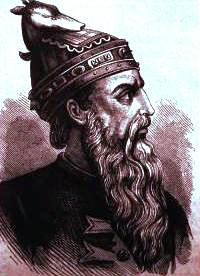
(Gjergj Kastrioti Skënderbeu, around 1403 – 1468)
One of the greatest figures of Albanian history has been and remains George Kastrioti Skanderbeg. He is remembered as a nobleman and leader of the struggle for independence from the Ottoman rule in Albania. Skanderbeg was born around 1403 and, after his father Ivan Kastrioti sided with the Ottomans, as a child he was sent to Sultan Murad II. In the Ottoman Empire he passed military training, converted to Islam, received the title of Bey and the name Iskender (Alexander). He participated in the military invasions of the Empire in which he stood out as a courageous, skillful and a good warrior occupying a high place in the Ottoman hierarchy. He especially enjoyed the respect from Sultan Murad II, who gave him tenure in different parts of Albania under his rule. After the defeat of the Ottoman army near Niš, Skanderbeg left the Sultan and went to Albania in 1443.
In Albania he partnered with rebels and armed people who wanted to liberate and defend themselves from Ottoman rule and attacks. In 1444, Skanderbeg gathered nobility in Lesh (Albania) and formed a military alliance, people's army, whose aim was to fight against the Ottoman Empire. Skanderbeg was placed on the forehead and named military leader. In the fighting in 1445, he won the Ottoman army in the field of Dibra, and already in 1447 he defended from the attacks on Kruja and freed greater part of Albania. Sultan Murad II in 1449 had been trying to penetrate into Albania, but failed. Apparently, he returned in 1450 with about 100 000 people besieged Kruja, but did not manage to conquer it and suffered heavy losses. During the year 1453, Skanderbeg defeated twice the Ottoman army of Sultan Mehmed II the Conqueror, but suffered defeat in the 1455 attack on Berat. The turning point, however, is 1466, when Sultan Mehmed II, with about 150 000 people, failed in an attack on Kruja as well as in one another invasion in 1467. Who knows what would have happened and in what direction would have been going the history of Albania if Skanderbeg hadn’t suddenly died of malaria in 1468? After the death, his area went under Venice, which at one time was managing to defend it from the Ottoman attacks, but in 1478 Kruja was finally occupied by Sultan Mehmed II and in the following year he capitulated and Shkodra. The same year, Venice lost its possessions in Albania, which became part of the Ottoman Empire.
Although resistance existed for some time, after the death of Skanderbeg the organized struggle of the Albanian people against the Ottoman authorities ended. In Skanderbeg’s honor and as a sign of acknowledging his role in the history of Albania and the Albanian people, it has been established a medal under his name to be awarded for contribution to the defense, reinforcement and enhancing the development of Albania. In the main square of Tirana is situated his monument and the square itself carries his name. There is, also, a museum in Kruja that bears the name of Skanderbeg and that is one of the most visited museums in the whole Albania. It contains objects, reproductions and documents that, among other things, tell about historical events in the fifteenth century. Skanderbeg is also remembered in other Balkan and European countries, because of his contribution to the defense of the Ottoman conquest and association of the people in this fight. There is an interesting fact that one of the best and most famous cognac produced in Albania bears the name of Skanderbeg.
Prepared by: Marta Blanuša

